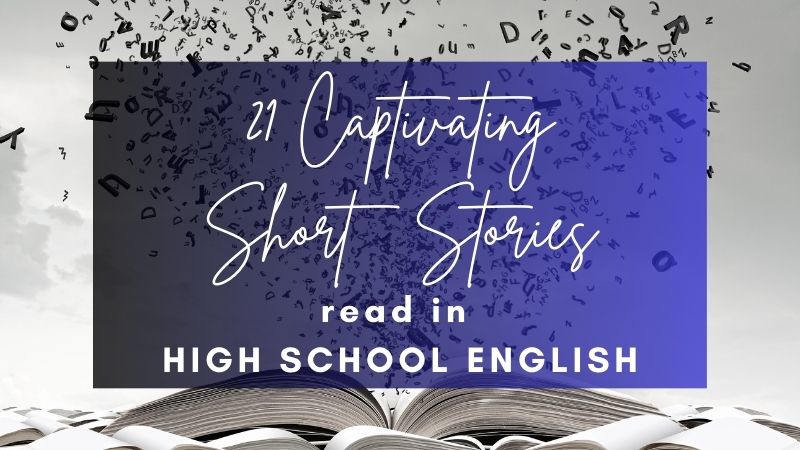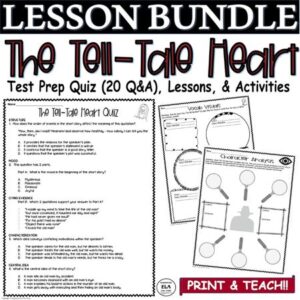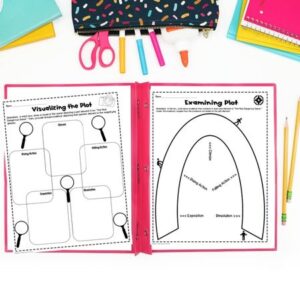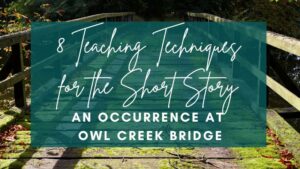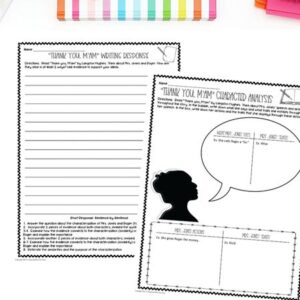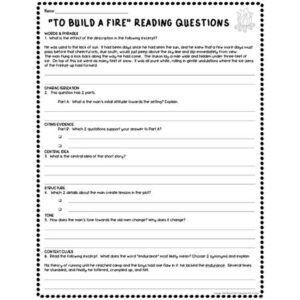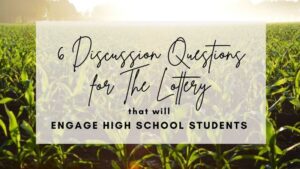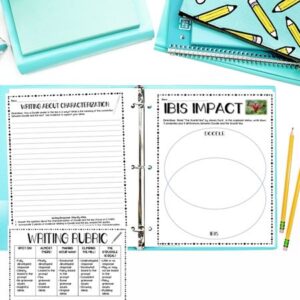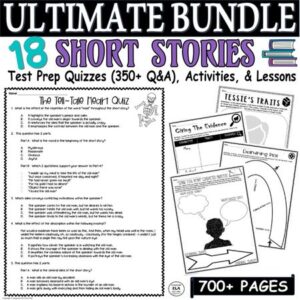When I think of my own high school English experiences, I remember reading loads of literature and writing a ton! While novels and plays consumed about half of what I was required to read, short stories read inside and outside of class were always a breath of fresh air for many reasons. The main reason is that they were SHORT!
Novels can take weeks to wade through, but short stories read and analyzed as a part of a mini-unit can be completed within a class or two!
I didn’t fully appreciate short stories read as a part of my own educational experience until becoming a teacher, but NOW they are my go-to texts! No matter the level of your high school students, practically ANY short stories read within the class period or finished outside of it can be taught!
Keep reading for 21 Captivating Short Stories Read in High School!
Need help with Test Prep that includes one of the most popular short stories read in high school? Check out this FREE Pack of 3 Test Prep Activities to help students achieve success on standardized tests!

Why should we include more short stories read in high school?
1. They are quick to read.
Most short stories read in high school can be completed within about 10-45 minutes. This timing typically includes only the actual reading, but still, within a week, students can have read, analyzed, and written about a short story easily and effectively!
2. They provide an easy win for students.
Let’s face it. When we have to spend WEEKS reading longer texts like Romeo and Juliet or To Kill a Mockingbird, it can be exhausting, especially for struggling readers. By the end of a class or two, short stories read and enjoyed quickly can be a big win for these students!
3. They are usually very engaging.
Because of their length, short stories read as a part of English class can be super engaging! While some students may not like every short story you assign in your class, most will at least find something interesting within a short story! And if you take breaks after chunks and guide students through the reading process, more engagement will inevitably occur.
4. They are filled with universal ideas.
No matter the time period of the setting or when the story was written, students can usually connect in some way to major ideas within short stories read today. There are so many short stories that cover the topics of family, love, hate, war, nature, conflict, friendship, etc. all within the same text!
5. They are easily integrated into any unit.
You can pretty much integrate short stories into any unit you are teaching. They can connect to themes, subject matter, time period, or even language! In fact, I would argue that we should have more short stories read in class as opposed to outside of class to make sure our students are reading and growing in their comprehension and analytical skills.
20 Compelling Short Stories Read in High School & Teaching Ideas
1. “The Tell-Tale Heart” by Edgar Allan Poe
The most widely read short story is Edgar Allan Poe’s “The Tell-Tale Heart.” This story tells of a mentally ill young man who plans the death of an older man with a strange eye. If you have not read this story with your students or even if your students read the story in middle school, it is time to take another look.
Edgar Allan Poe’s short stories read in both middle and high school offer more than most horror tales because of their timely themes and higher-level language!
As high school teachers, we can up the ante by focusing on viewing the story through the lens of psychology with an examination of the protagonist’s progressive internal and external characterization.
DIFFERENTIATED ACTIVITY IDEAS:
- Locate textual evidence that describes a specific character. Then, students will identify character traits based on the evidence. You can use a graphic organizer or chart to log the information!
- Analyze how the character develops throughout the story by discussing, depicting, or writing about these traits from start to finish. A small group discussion, visualization activity, or paragraph outline will help students accomplish this goal!
- Identify the theme(s) of the story by exploring why the author included this specific character development. By following the above 2 steps, students will be more ready for this activity! They can create a presentation, write a 2-4 paragraph literary analysis, or draw the story in various ways (i.e. comic strip, graphic book, etc.).
Click below to make lesson planning for “The Tell-Tale Heart” a breeze!
2. “The Most Dangerous Game” by Richard Connell
I absolutely love this particular story and remember this and other short stories read during my junior year. (I had a horrible 9th/10th teacher who ONLY focused on grammar.) This tale describes a hunter who becomes the hunted on a mysterious island.
While the story is a bit longer, your students will be engaged right from the beginning!
If you have not introduced plot elements yet or if your students need a refresher, this short story is a perfect fit!
DIFFERENTIATED ACTIVITY IDEAS:
- Identify the plot elements in the story by locating specific pieces of textual evidence for each idea. Using a plot diagram here will be super helpful!
- Use the plot diagram to create a visual of each element.
- Analyze how the plot elements contribute to the story’s meaning.
3. “An Occurrence at Owl Creek Bridge” by Ambrose Bierce
If you have not read this classic Civil War story, you are missing out! We have a soldier who cannot differentiate between dreams and reality as he waits for death. Integrating this story with other texts like the Gettysburg Address and the song “When Johnny Comes Marching Home” will help students make connections to this important historical time period!
DIFFERENTIATED ACTIVITY IDEAS:
- Differentiate between the protagonist’s dreams and his reality with textual evidence from the story; students can write about each or both!
- Visualize the setting, real and otherwise, by using descriptions (2, 4, or 6) to support the visualization.
- Physically draw or use technology to create a movie poster of the story, a character “photo,” or a story booklet.
Want more ideas for teaching short stories read in high school like “An Occurrence at Owl Creek Bridge?” See below!
4. “Thank You, Ma’am” (also known as “Thank You, M’am”) by Langston Hughes
This short story by Langston Hughes is not necessarily a difficult read, but it will appeal to your 6th-10th grade students because of the language, themes, and characters! Hughes’ message revolves around grace and forgiveness and will appeal to any student!
DIFFERENTIATED ACTIVITY IDEAS:
- Begin with a focus on character traits; students can identify textual evidence related to what a character says, how the character is described, and what the character does.
- Make connections between the evidence and characterization by linking a trait to each piece of evidence.
- Write about how a character develops or changes from the story’s start and finish by referencing different traits.
Want reading comprehension and analysis activities right at your fingertips? Click HERE!
5. “The Masque of the Red Death” by Edgar Allan Poe
In the post-Covid era, this short story has become even more relevant. As many nations “closed” and people attempted to hide from this virus, we can see a correlation to those in Poe’s “The Masque of the Red Death!”
DIFFERENTIATED ACTIVITY IDEAS:
- Introduce symbolism (something that represents something/someone else) and have students identify possible symbols within the story. (Ex. clock, rooms, masque, dancing, etc.)
- Locate examples of symbols that center on death and find textual evidence for each piece of symbolism.
- Write about or visualize a specific symbol and explain how it plays a role in the story’s meaning.
6. “The Cask of Amontillado” by Edgar Allan Poe
I think most of us love a story about REVENGE…as long as we are not personally affected. Am I right? From the start, we know Fortunato’s fate at the hands of Monstresor. How the antagonist accomplishes his vengeance is strangely intriguing and horrifying!
DIFFERENTIATED ACTIVITY IDEAS:
- Teach about irony: verbal, dramatic, and situational. Encourage students to focus on 1 type and write down evidence for that type of irony and explain the evidence in their own words.
- Have students practice and read aloud the interaction between Fortunato and Montressor; it is full of verbal irony on the part of Montrestor.
- Encourage students to rewrite Montresor’s words; what is he really saying?
7. “To Build a Fire” by Jack London
I am a HUGE fan of Jack London, particularly because of his use of simple language about nature. “To Build a Fire” exemplifies the everyman in a nature-based setting by asking the ultimate question: “Would you have survived?”
Focusing on the universal idea of survival is a fun way to read this text!
DIFFERENTIATED ACTIVITY IDEAS:
- Define the term “setting” and investigate various descriptions of the setting throughout the story.
- Introduce the term “mood” and discover how the mood changes based on the setting by locating descriptions related to the setting.
- Explore how the setting and mood relay an important message (theme) of the story.
8. “The Cactus” by O. Henry
A lesser-known story by O. Henry, “The Cactus” describes a love story thwarted by pride and miscommunication. It’s not a long read, and your students will enjoy reading about the topic of love and relationships presented in an interesting way. Lighter-hearted, humorous short stories read in English can be a nice addition to your curriculum!
DIFFERENTIATED ACTIVITY IDEAS:
- Research 5 words from the story; students can define each word, locate a synonym and antonym, and creatively visualize each word.
- Discuss the importance of 3 words; what words are the most important in this story? Explain.
- Give each paragraph a heading/title and underline 3 words to support the headline/title.
9. “After Twenty Years” by O. Henry
If you need a quick and easy read, “After Twenty Years” by O. Henry is a top choice for short stories read in ANY ELA class! This story of friendship depicts a conflict between integrity and loyalty, which many of our students can relate to! It is always a benefit when short stories read in class can connect to our students in some way! You cannot go wrong with any O. Henry short stories read in your classroom!
DIFFERENTIATED ACTIVITY IDEAS:
- Model how to underline or highlight character descriptions as you read the first page of the story and require students to do the same as you read aloud the rest of the story.
- Ask students comprehension questions revolving around characterization. Start with a couple and encourage students to answer them in complete sentences.
- Help students develop their ideas into fully formed paragraph responses. You could even have students write a journal entry from a character’s perspective.
10. “The Lottery” by Shirley Jackson
You are in for some FANTASTIC FUN if you have not yet read “The Lottery!” The title alone will appeal to your students! Short stories read with captivating titles make our jobs a bit easier, right?
DIFFERENTIATED ACTIVITY IDEAS:
- Define foreshadowing and identify descriptions related to the setting.
- During the reading, students can annotate for imagery with a focus on the characters, their actions, and the dialogue.
- After reading, students can create their own questions and conduct their own Socratic Seminar! This process can work for any short stories read in class!
Check out short stories read in high school like Shirley Jackson’s “The Lottery!” Click for 6 Discussion Questions for “The Lottery!”
11. “The Pedestrian” by Ray Bradbury
Seemingly innocuous, the title of this dystopic text belies the eery truths within short stories read through the lens of today! Taking less than 10 minutes to read, short stories read in class like “The Pedestrian” offer students an opportunity to dig deeply without spending too much time deciphering the language or wading through long passages.
DIFFERENTIATED ACTIVITY IDEAS:
- Underline major events in the story and create a top 5 list of significant moments.
- Summarize the story by referring to the most important events and use evidence to support your ideas.
- Answer the question through a visual: What happens to Leonard? What does he look like 30 days into the future?
12. “The Gift of the Magi” by O. Henry
One of the most classic short stories read in high school or upper middle school classrooms is “The Gift of the Magi” by O. Henry. Instead of death and sadness within many popular short stories, this tale relays the frustration, miscommunication, and self-sacrifice people experience in marriage. Plus, it is perfect for short stories read during the holiday season.
DIFFERENTIATED ACTIVITY IDEAS:
- Teach about literary devices like allusion specifically; there are 4 main types: biblical, mythical, literary, and historical. If you start by reading the story of Jesus’ birth, it will give your students a basis for understanding this short story a bit better.
- To build on the reading of the Biblical story and this short story, try helping students identify the biblical allusions and symbols within. What attributes do the characters display? What symbols do they see? Be sure to have students take notes as they read.
- Ask students to comment on the symbols and allusions beyond the meaning. Ask the questions: Why are they there? How are they important? What do they relay about the theme of the story?
13. “The Monkey’s Paw” by W.W. Jacobs
This accursed tale illustrates the timeless saying: “Be careful what you wish for.” No matter the age, your students will enjoy the eerie atmosphere, the spooky moments, and the resolution! Broken up into 3 parts, this story can be read in less than a day and analyzed with ease. Short stories read in chunks and focused on a theme really help a teacher out 🙂
DIFFERENTIATED ACTIVITY IDEAS:
- Work to compare and contrast the mother and the father by annotating various sentences throughout the story.
- Then, you can use a Venn Diagram or other organizer to synthesize the information gathered about both characters.
- Create a 2-part Movie Poster; split the story through the mom’s and dad’s perspectives.
14. “Lamb to the Slaughter” by Roald Dahl
Alfred Hitchcock’s television episode follows Roald Dahl’s story “Lamb to the Slaughter” quite beautifully. A young, pregnant wife learns her husband is about to leave her; she enacts a clever plan to eliminate the murder weapon and get away with her husband’s homicide. Short stories read in middle school and high school like “Lamb to the Slaughter” provide so many options for varying levels of analysis!
DIFFERENTIATED ACTIVITY IDEAS:
- Start out the lesson with an analysis or quickwrite of the title of the story: What do you think the title means? What words are important and why?
- As you read with your students, underline any words related to suspense. Think about characters, setting, and actions.
- After the story is read, link the title with the story and come up with a new title and tagline for this story or television episode. Definitely, give students the opportunity to present their ideas to the class!
15. “The Scarlet Ibis” by James Hurst
I will never forget reading this short story for the first time with my ninth graders in 2006. As a new teacher, I had never read the story, and I’m not going to lie. I may have teared up a bit. A story of two brothers in a somewhat typically fractious relationship, students will love this story for its emotional impact and symbolism throughout.
DIFFERENTIATED ACTIVITY IDEAS:
- Character development and perspective will help your students focus as they read this story. Assign either Doodle and/or the narrator to follow and underline/write down descriptions or dialogue related to the character.
- Expand on the above activity by having students write about how a specific character changes from start to finish. Students can also visualize this change based on their evidence.
- Lastly, to up the ante, students can identify the theme of the story: How does character development contribute to the theme (message) of the story?
16. “The Sniper”
I did not read “The Sniper” until this last year. The title alone will captivate many of your students who love anything about the history of war or specific video games. The ending alone will surprise your kiddos, so be prepared. Short stories read in ELA that relate to social studies, science, history, etc. will allow students to make more permanent connections to major concepts!
DIFFERENTIATED ACTIVITY IDEAS:
- Start out by discussing perspective and point of view; 1st (personal in the main character’s voice), 3rd limited (focused on the main character but not directly in the main character’s voice), & 3rd omniscient (from the narrator’s voice about many characters). Locate examples of each and identify the perspective in the story.
- While reading, follow the perspectives of different characters. How might they see certain situations differently?
- After reading, encourage students to write the story from another character’s perspective or create sentences from varying perspectives.
17. “The Veldt” by Ray Bradbury
Ray Bradbury short stories read in ELA hit almost too close to home, especially with what is going on in relation to children and technology today. This dystopian piece of literature tells of self-absorbed children consumed by technology to the point that they are willing to put their own parents in mortal danger. Plus, this story complements other short stories read in English like “The Pedestrian!”
DIFFERENTIATED ACTIVITY IDEAS:
- This story begs the question: How MUCH does technology affect us? Start out the reading by modeling how to annotate for a specific purpose i.e. anything related to technology.
- Make connections between the children and the impact of technology; answer the question: In what ways does technology play a role in the story?
- Conduct a Socratic Seminar on technology. Discuss the story and extend ideas into the real world. Has technology made humanity better? How? Trust me; students will take these questions and run with them. You won’t have to do much to encourage engagement!
18. “The Necklace” by Guy de Maupassant
I don’t think I could go a single year without perennial classic short stories read as a part of my curriculum like “The Necklace!” This piece of literature connects with something that we all struggle with: selfishness. We want what we want when we want it, and this state of being almost inevitably leaves us with unintended consequences. Check out the story here!
DIFFERENTIATED ACTIVITY IDEAS:
- Ask these questions: What traits define you? Are they mostly positive or negative? Locate 2 traits that define the protagonist of the story based on evidence from the first several paragraphs.
- Help students to locate 2 more traits or descriptions of the protagonist from the middle of the story. Compare/contrast these traits to students’ own lives: Are we like her in any way? How?
- Give students the independence to find 2 last traits from the end of the story based on evidence. Has the protagonist learned her lesson? Why or why not? Do you learn through other people’s experiences or your own?
19. “A Vendetta” by Guy de Maupassant
This lesser-known of the Maupassant short stories read in high school classes, “A Vendetta” is an absolute must-read. A mother plans and enacts her vengeance on her son’s killer with intelligence and cleverness beyond societal expectations. Pair this story with “The Cask of Amontillado” and “A Poison Tree” for a mini-unit revolving around revenge!
DIFFERENTIATED ACTIVITY IDEAS:
- A focus on imagery is VITAL for this short story. Define imagery as a description linked to one of the five senses and read the exposition with imagery in mind. Take notes on evidence related to imagery used in the setting, characters, and actions!
- To challenge your students, have them focus on a specific scene, visualize the scene (drawing/creation of some sort), and answer this question in a couple of sentences: How is imagery important in conveying the mood of the story?
- To prepare students for upper high school and college courses, assign a small literary analysis by answering the question: How does imagery contribute to the meaning and/or theme of the story? Use evidence to support your ideas. For more struggling readers/writers, you could assign a single-paragraph response, but stronger writers will need 4+ paragraphs to delve into and support their ideas!
20. “Click Clack the Rattle Bag”
Although short stories read in middle school may not be developmentally appropriate for high school students, I think “Click Clack the Rattle Bag” can be included in the high school classroom. Integrating this story with twist-ending tales like “The Lottery” and “The Cask of Amontillado” can help students read, analyze, and write about many short stories at the same time for a synthesis paper!
DIFFERENTIATED ACTIVITY IDEAS:
- Define “twist ending” as well as “foreshadowing” and as you read, students can take notes on anything that sticks out or might foretell what could happen in the future. When students write as they read, they are more likely to remember what is going on. Then, when you read the resolution, they can look back on their own notes and ideas!
- Examine shift in mood. Mood is the emotion felt by the reader/audience, made manifest by the setting, dialogue, and/or actions within the story. Take notes on how the mood changes throughout the story. Identify the evidence and link each piece of evidence to a specific mood word.
- Create a film scene booklet from start to finish WITH a possible ending. As we don’t know for sure what happens, your students can decide based on the evidence. Make sure to do a Gallery Walk afterward to see their classmates’ ideas!
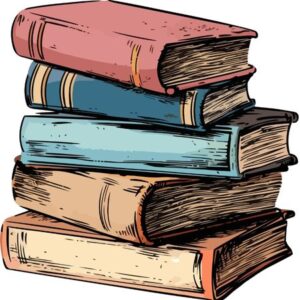
21. “Story of an Hour”
“Story of an Hour” is on my list of short stories read throughout the year because of its importance in literature. A wife hears of her husband’s death and slowly realizes the freedom she will experience as a result. The twist ending will make most of your students either laugh or cry…
DIFFERENTIATED ACTIVITY IDEAS:
- For more struggling readers, you will most certainly want to focus on comprehension. Center all of your questions on the protagonist. How is she portrayed at first? How does she change? What does she realize and how does she react? What is her tone and how does it change? What really happens to her at the end of the story? Perhaps, a simple plot diagram chart would help students follow the most important events in the story.
- To expand on students’ critical thinking skills, be sure to consider the theme or themes from the passage. What is the writer trying to relay about the state of womanhood? the impact of marriage on women?
- In order to level up, introduce feminist theory or gender theory to your upper-level students. Together, you can list typical expectations of gender based on the past versus today. Then, students can write about, research, or present their ideas in the context of the story.
SHORT STORIES READ IN HIGH SCHOOL RESOURCE
This Short Stories read in Middle and High School ULTIMATE BUNDLE with Lessons, Quizzes, and Activities uses the Common Core standards and includes reading comprehension test prep QUESTIONS and ANSWERS for 18 short stories such as “Thank You, Ma’am,” “The Most Dangerous Game,” “The Monkey’s Paw,” “The Tell-Tale Heart,” “After Twenty Years,” “The Gift of the Magi,” “The Veldt,” “The Lottery,” “The Pedestrian,” etc. modeled after various state reading exams!
Make teaching short stories read and analyzed SIMPLE & EASY!
Crave more fun ideas for teaching short stories read in middle and high school? Check out my store Kristin Menke-Integrated ELA Test Prep!

